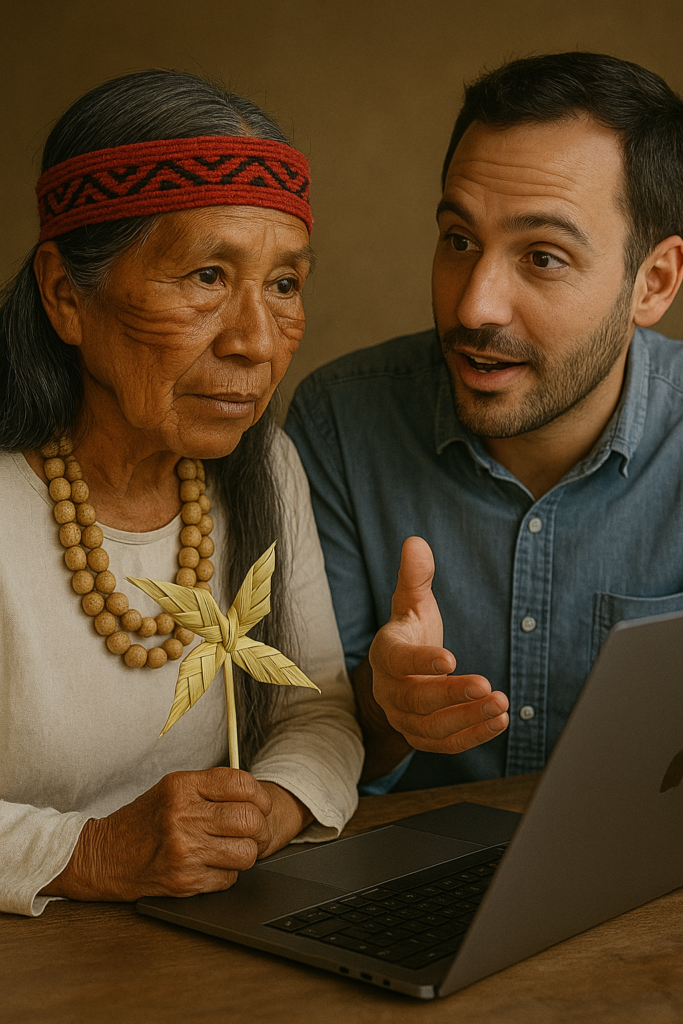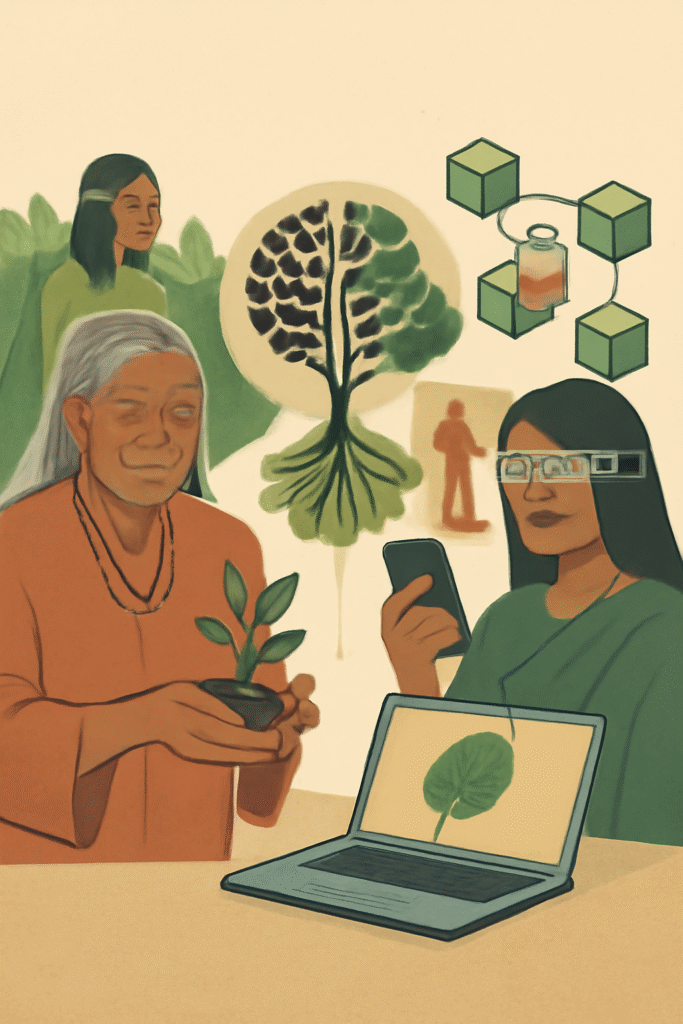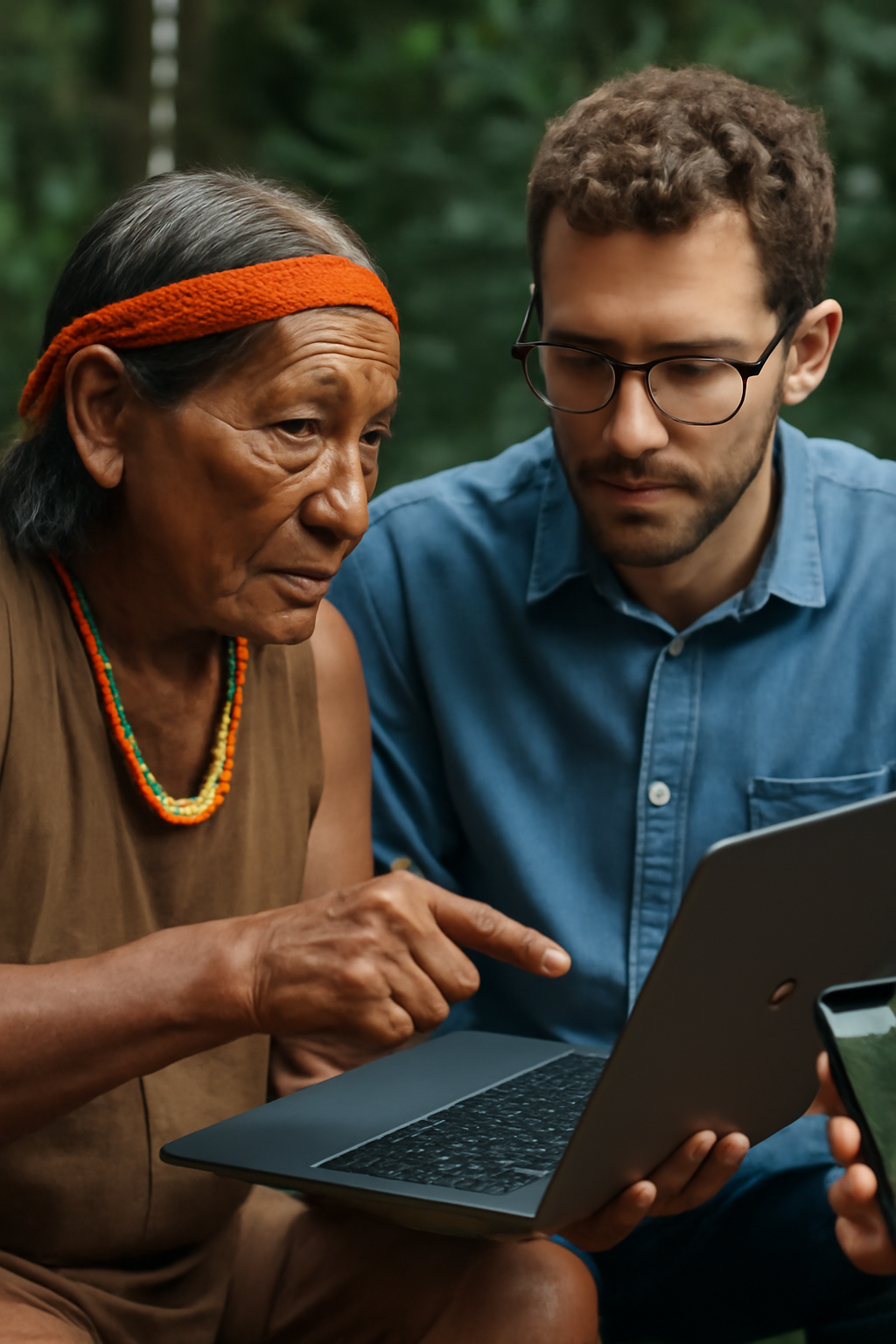Como o Conhecimento Indígena Está Moldando a Inovação Ética
O Potencial Inexplorado da Sabedoria Testada pelo Tempo
Enquanto a tecnologia de ponta domina as manchetes, uma revolução mais silenciosa está em curso — uma em que anciãos da floresta e cientistas de dados colaboram, em que padrões algorítmicos espelham ecossistemas naturais, e em que smartphones se tornam ferramentas de preservação cultural. Isso não é apenas progresso; é progresso com propósito.
E se a chave para resolver as crises do século XXI estiver em sistemas de conhecimento refinados ao longo de milênios?

Comunidades Indígenas: Bibliotecas Vivas da Sustentabilidade
Você já presenciou uma solução tão elegante que fez a tecnologia complexa parecer desnecessária?
Entre as mais de 300 nações indígenas do Brasil, sobreviver não significa dominar a natureza, mas compreender sua linguagem:
- Os “mosaicos de fogo” dos Kayapó — queimadas controladas que evitam megaincêndios, hoje estudadas pela NASA.
- Os calendários lunares dos Tukano — capazes de prever migrações de peixes com uma precisão que nenhum aplicativo consegue reproduzir.
- Os bancos de sementes do Xingu — protegendo mais de 300 variedades agrícolas contra o colapso climático.
Isso não é folclore — é ciência aplicada sem desperdício industrial.
Reimaginando a Inovação a partir de uma Lente Indígena
A tecnologia moderna costuma perguntar: “Podemos construir?”
A lógica indígena pergunta: “Devemos construir?”
Essa simples inversão muda tudo.
Estudos de Caso em Tecnologia Ética
🔵 IA bioinspirada
Caçadores Yanomami acompanham o comportamento animal por meio de sinais ambientais sutis. Hoje, startups de tecnologia imitam essa lógica usando redes neurais que “observam” ecossistemas como rastreadores tradicionais, reduzindo falsos alertas em sistemas de conservação.
🟢 Blockchain para direitos territoriais
Lideranças Munduruku firmam parcerias com programadores para criar registros digitais de terras à prova de adulteração, usando blockchain. O resultado é a união do conhecimento territorial ancestral com a segurança criptográfica.
🟠 Narrativas em Realidade Aumentada
Para que histórias orais não se percam, jovens Guarani utilizam aplicativos de realidade aumentada que sobrepõem narrativas ancestrais às paisagens físicas, transformando florestas em livros vivos de história.
Quatro Mudanças Radicais Quando a Tecnologia Escuta a Tradição

1️⃣ Da extração à reciprocidade
A tecnologia extrai dados; os sistemas indígenas devolvem por meio de rituais como o plantio de sementes. Imagine algoritmos que “retribuem” aos ecossistemas.
2️⃣ Do design centrado no humano ao design centrado na vida
Enquanto o Vale do Silício projeta para usuários, os Ashaninka projetam para onças, rios e gerações futuras.
3️⃣ Da velocidade ao tempo certo
A agricultura indígena respeita ciclos naturais — uma lição direta para uma indústria de IA obcecada pelo “tempo real”.
4️⃣ Da propriedade ao cuidado
Nenhuma língua indígena possui a expressão “recursos naturais” — apenas “parentes”. Como a tecnologia mudaria se víssemos os dados como família?
Direto ao ponto: inovação sem ética é só aceleração. Quando a tecnologia aprende com a sabedoria ancestral, ela deixa de correr — e passa a cuidar.

Sua vez: passos práticos para uma tecnologia com raízes
Experimente a “Tecnologia Lenta” — passe uma semana usando aplicativos apenas para necessidades (não para desejos), inspirando-se na intencionalidade indígena.
Mapeie sua biorrefino — use o Google Earth para identificar os territórios indígenas originários onde você vive. O que as práticas de manejo da terra desses povos podem ensinar?
Apoie tecnologia indígena — acompanhe projetos como a Amazon Sacred Headwaters Initiative, que combina mapeamento por GIS com o conhecimento dos anciãos.
Uma nova bússola para a inovação
A próxima revolução tecnológica não virá de chips mais rápidos, mas de escuta mais profunda — das linguagens das florestas e da sabedoria silenciosa de quem sustenta a vida há séculos.
Como lembra o líder tupi Ailton Krenak: “Rios não precisam de algoritmos — precisam de defensores.” Talvez a tecnologia mais avançada seja saber quando baixar a tela e ficar ao lado deles.
